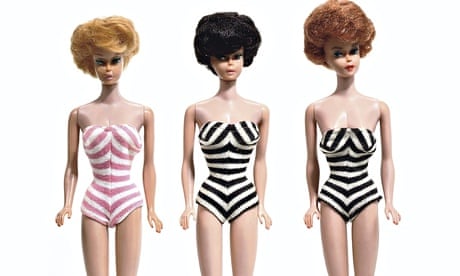Toy manufacturer Mattel's recent marketing campaign in Sports Illustrated proves nothing quite kicks off an argument on the internet like the subject of children and advertising. Thanks to an advert taken out by Mattel, you can now get your scantily clad swimsuit edition advertised by Barbie.
When you get over the initial shock of a hypersexualised plastic toy selling sun, sex and sand, you start to unpick the symbols behind it. It's creepy. A child's doll – which is no stranger to its own controversy of marketing an unrealistic body image to young girls – is being used to sell a magazine bought by (mostly) men in search of titillation.
Comedian Bill Hicks called on everyone working in advertising or marketing to kill themselves. "There is no rationalisation for what you do and you are Satan's little helpers. Kill yourselves."
Why the hate? There's something of the "social control" model when it comes to marketing to children. For instance, only 5% of US women have the body type portrayed as the ideal in advertising, yet 69% of teenage girls said that magazine pictures influenced their idea of a perfect body shape. Contrast this with a Yale University study which found that the more fast food ads children were exposed to, the more likely they were to eat the stuff.
"If you look at TV commercials, you start seeing how product is marketed by gender," begins Jennifer Pozner, a media literacy educator and author of Reality Bites Back: the Troubling Truth About Guilty Pleasure TV.
"Boys' products tend to be sold with dark colours, language that stresses immediacy and usually focuses on a lone boy dominating his play world. Girls get lighter colours: the pinks, the lavenders. The language is more about nurturing, friendship, popularity and consumption."
Goldieblox, a new toy unleashed to the US market by engineer Debbie Sterling says it is out to disrupt the "pink aisle" by inspiring young girls to become engineers. The model of play takes the kinetic and building functions of K'nex and other construction toys and ties in a storyline. But wait a moment, if Goldieblox is meant to redress the gender normative imbalances of the toy industry, why is it all in lavender and yellow?
"We're not here to say pink and princesses are bad," says Sterling. "My goal is simply to give young girls the options that I never had, so they might consider pursuing engineering at a much younger age than I did."
So does gender-specific advertising create or reinforce stereotypes about men and women? Research carried out by Professor Judith Blakemore at Purdue University claims that the development of physical, cognitive, academic, musical, and artistic skills occurs more with less gender-typed toys. But marketing experts argue that is down to parenting.
"The critical factor is the adult who buys the product - the shopper," says John Nevens, co-founder of marketing specialists Bridgethorne. "It could be that they want their daughter to focus on an engineering type activity, or that they want to indulge her or they may just buy without any real thought to gender. A brand has to meet the shopper's need, yet so many brands are focused on the consumer."
Erin Simons, a social media consultant at Caliber, questions the effect of fashion marketing and whether those too young to understand advertising should be targeted by it. Children have "grown up with social media. Inspired by celebrities and fashion models, many young girls feel pressured to upload highly sexualised photos of themselves in order to receive validation from peers. Fashion marketing is no longer restricted to billboards or magazines, but entering into a seemingly personal space where vulnerable young girls look to emulate it. Brands enforce the perceived importance of image and identity among a very impressionable demographic."
Professor Alex Molnar is publications director of the National Education Policy Center and one of advertising's biggest critics. He gives an example of how marketing capitalises on gender identity.
"When the full-page Barbie ad ran, it looked like Barbie was taking on a pro-feminist view. Saying that girls and women are free to be whomever they want, and saying that real women don't wear high heels or appear in swimsuit [magazine] issues is regressively confining women. That kind of thing is something that marketing does very well. And the best marketing is like the best propaganda – it always contains a kernel of truth."
Although Mattel and Sports Illustrated have yet to reply to our request for comment, Barbie herself is, if you believe the marketing,"#unapologetic". The Barbie Twitter feed says girls should not be "judged by how she dresses, even if it's in heels".
This more nuanced way of marketing to girls and women contrasts with ads a generation ago that prescribed a woman's role in society as that of a homemaker. The saying that a woman must be a maid in the parlour, a cook in the kitchen and a whore in the bedroom probably still rings true, but we've convinced ourselves that we're "free" of that. So you can guiltlessly accept marketed gender clichés such as "girls like pink and glittery things" because, you know, feminism.
Join the community of sustainability professionals and experts. Become a GSB member to get more stories like this direct to your inbox

Comments (…)
Sign in or create your Guardian account to join the discussion